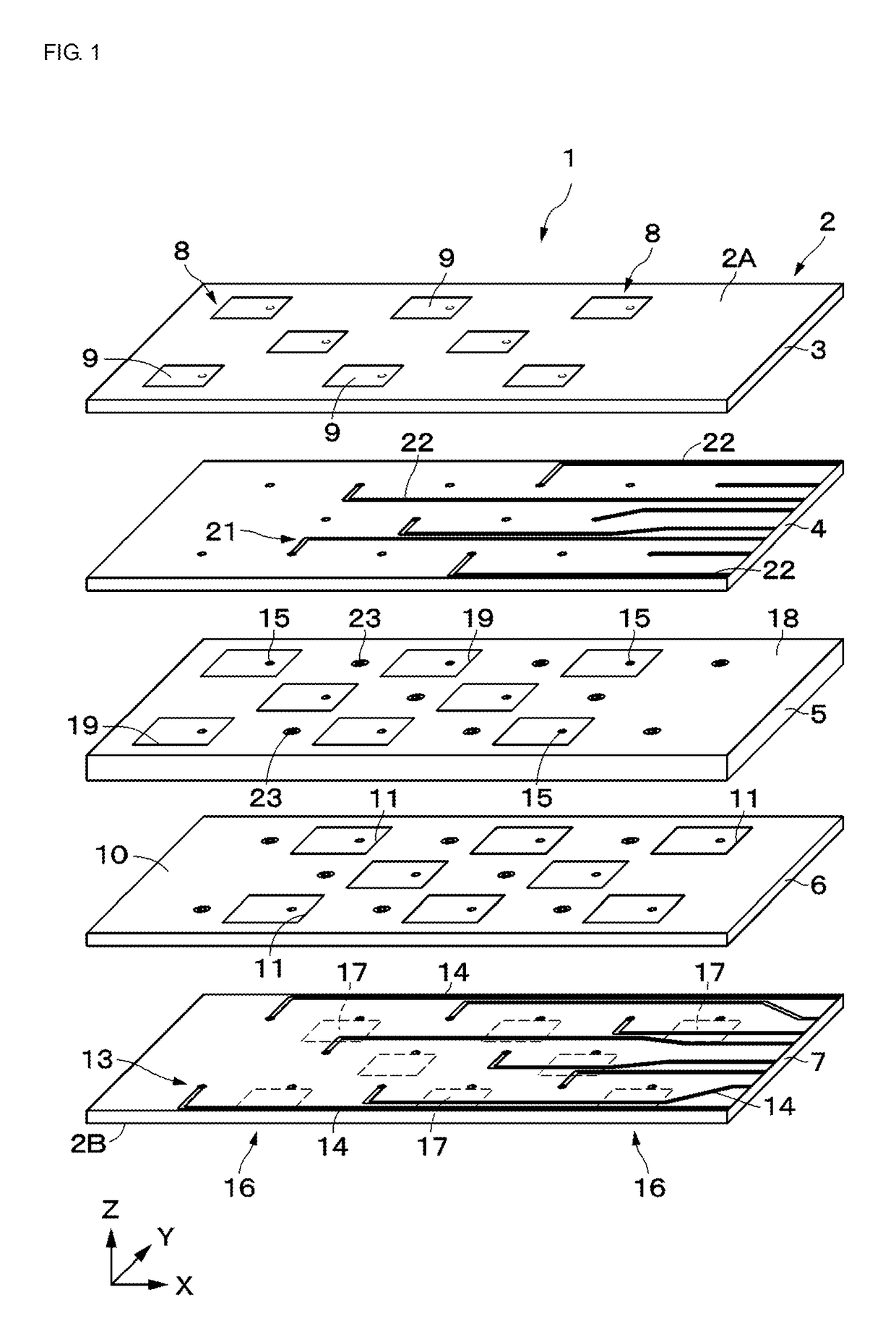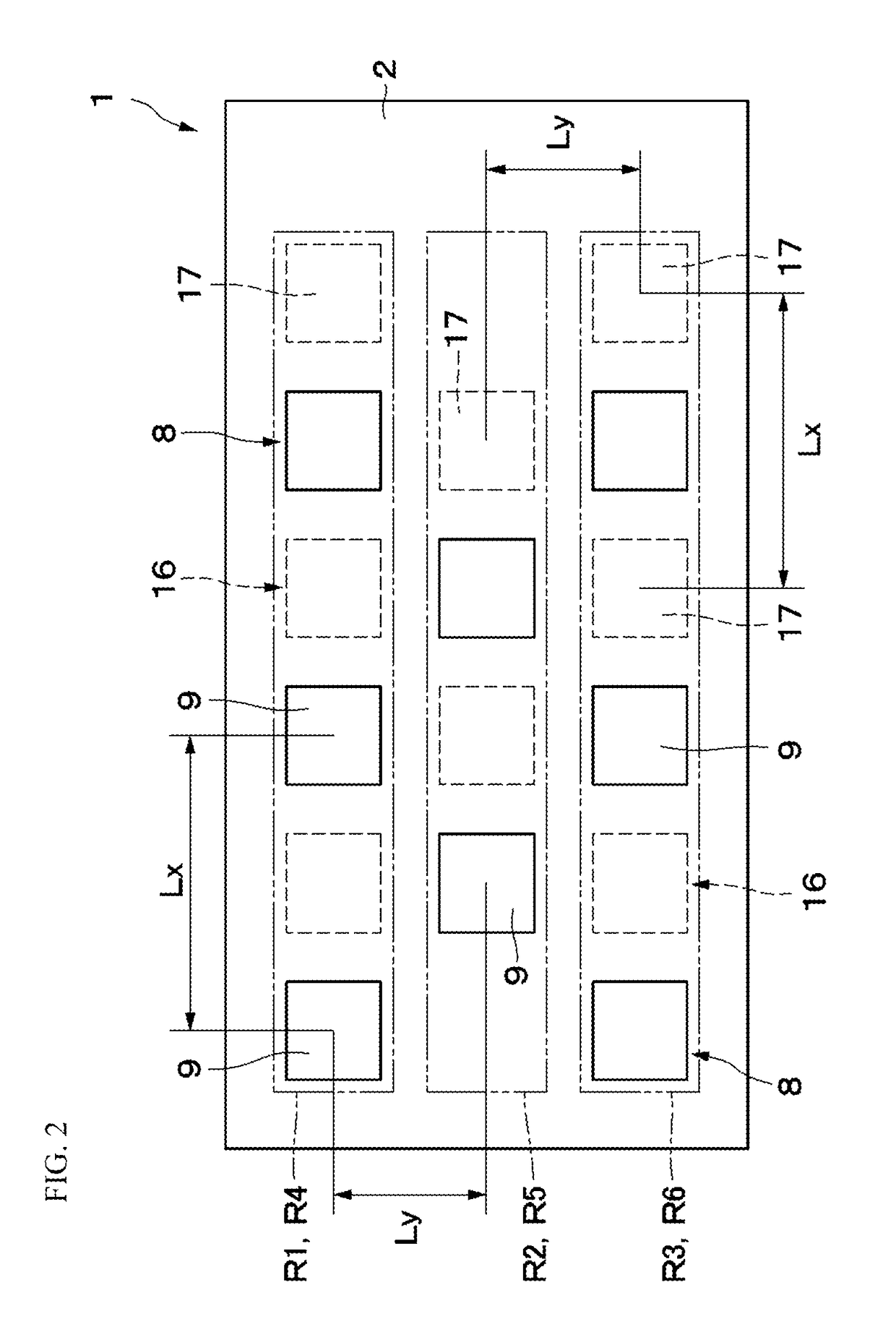Array antenna
a technology of array antennas and antennas, applied in the field of array antennas, can solve the problems of increasing device size and complicated structure, and achieve the effect of reducing the size of array antennas and increasing the area utilization efficiency of substrates
- Summary
- Abstract
- Description
- Claims
- Application Information
AI Technical Summary
Benefits of technology
Problems solved by technology
Method used
Image
Examples
first embodiment
[0039]An array antenna 1 according to the present disclosure is illustrated in FIGS. 1 to 5. The array antenna 1 includes a multilayer substrate 2, a front-side antenna portion 8, and a back-side antenna portion 16.
[0040]The multilayer substrate 2 is formed in a flat shape parallel to the X-Y plane among the X-axis, Y-axis, and Z-axis directions that are mutually orthogonal. The multilayer substrate 2 has a dimension of several mm to several cm in the X-axis and Y-axis directions and a dimension of several hundred μm in the Z-axis direction that is the thickness direction.
[0041]The multilayer substrate 2 is a printed circuit board obtained by laminating five layers, for example, thin insulating resin layers 3 to 7, from a front side 2A to a back side 2B. As an example of the multilayer substrate 2, a resin substrate is used. However, the multilayer substrate 2 may be a ceramic multilayer substrate obtained by laminating insulating ceramic layers or a low temperature co-fired ceramic...
second embodiment
[0076]In the second embodiment, the front-side radiation elements 33 and the back-side ground layer 18 are formed on the same layer and the back-side radiation elements 37 and the front-side ground layer 10 are formed on the same layer. However, a radiation element and a ground layer may be on different layers.
[0077]In the array antennas 1 according to the first embodiment and the array antenna 31 according to the second embodiment, a plurality of strip lines, the strip lines 14 and the strip lines 22, are formed. If there is no need to scan a radiation beam in the X-axis direction and the Y-axis direction, a common signal may be supplied to the front-side radiation elements 9 via a strip line 42 having an end portion divided into branches and a common signal may be supplied to the back-side radiation elements 17 via a strip line 43 having an end portion divided into branches like in, for example, an array antenna 41 that is the first modification illustrated in FIG. 10. This config...
third embodiment
[0085]A conductor connection portion is formed with the vias 52 in the third embodiment, but may be formed with, for example, a conductor film. This configuration can be applied to the second modification.
[0086]In the above-described embodiments, an array antenna (1, 31, and 51) includes eight front-side antenna portions (8 and 32) and eight back-side antenna portions (16 and 36). The numbers of the front-side antenna portions and the back-side antenna portions may be one, in the range of two to seven, or nine or more. The numbers of the front-side antenna portions and the back-side antenna portions do not necessarily have to be the same and may be different. This configuration can also be applied to the first and second modifications.
[0087]The front-side antenna portions 8 and 32 and the back-side antenna portions 16 and 36 are disposed on a plane extending in the X-axis direction and the Y-axis direction in the above-described embodiments, but may be arranged in a straight line. T...
PUM
 Login to View More
Login to View More Abstract
Description
Claims
Application Information
 Login to View More
Login to View More - R&D
- Intellectual Property
- Life Sciences
- Materials
- Tech Scout
- Unparalleled Data Quality
- Higher Quality Content
- 60% Fewer Hallucinations
Browse by: Latest US Patents, China's latest patents, Technical Efficacy Thesaurus, Application Domain, Technology Topic, Popular Technical Reports.
© 2025 PatSnap. All rights reserved.Legal|Privacy policy|Modern Slavery Act Transparency Statement|Sitemap|About US| Contact US: help@patsnap.com



